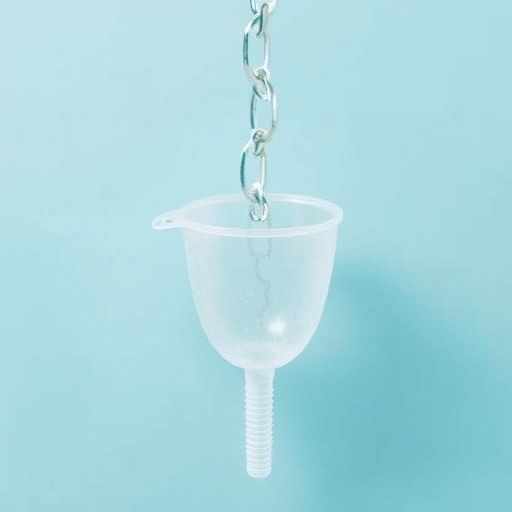In recent years, the quest for sustainable menstrual products has intensified as nearly two billion individuals worldwide seek environmentally conscious alternatives to single-use sanitary items. Menstrual cups, crafted from medical-grade silicone, have emerged as a promising reusable solution, offering advantages such as greater fluid capacity and reusability that can span years. Despite these benefits, widespread adoption is stymied by practical concerns including cumbersome cleaning rituals and the messiness associated with their removal. Scientific innovation now aims to address these barriers by engineering a menstrual cup that is not only more hygienic but also simpler to maintain through novel materials and design enhancements.
A team of researchers led by Tohid Didar and Zeinab Hosseinidoust at McMaster University has developed a two-pronged approach to improve the user experience of menstrual cups. Their strategy involves coating the inner and outer surfaces of a commercially available silicone cup with a specialized silicone oil. This hydrophobic coating fundamentally alters the cup’s interaction with biological fluids, dramatically reducing bacterial adhesion and resisting blood stains. The implications of this modification are profound: the silicone-oil-infused cup can be cleaned easily with just soap and water, eliminating what has traditionally required boiling or chemical sterilization.
The scientific rationale behind silicone oil coating utilizes its low surface energy and lubricant-like properties, which inhibit biofilm formation—a notorious source of infection and odor. Their experiments demonstrated that the treated cups significantly curtailed the colonization of Escherichia coli compared to their non-treated counterparts. The prevention of microbial adherence on both internal and external surfaces of the cup signals a paradigm shift in menstrual hygiene, offering users an easier, less time-intensive maintenance routine without compromising safety.
Beyond antimicrobial coatings, the researchers tackled the challenge of managing residual menstrual fluid within the cup during removal—a common inconvenience reported by users. By leveraging biomaterials, they fabricated an absorbent tablet composed of alginate fibers, derived from brown algae. These fibers were cross-linked with calcium chloride to form robust yet biodegradable tablets that can be inserted into the cup. Once in place, the tablet sequesters menstrual blood, clots plasma rapidly, and reduces the risk of spillage.
The absorbent alginate tablets exhibit remarkable properties that extend their usefulness beyond mere absorption. Laboratory tests confirm their biocompatibility, as they neither encourage nor inhibit bacterial growth, indicating safety for human use. Moreover, each gram of tablet material can absorb approximately 15 milliliters of whole blood over an eight-hour period, matching the volume capacity of the typical silicone-infused menstrual cup. The tablets also biodegrade fully over a period of four days when immersed in a saline aqueous solution, breaking down into non-toxic, biocompatible compounds that pose minimal environmental impact.
This integration of a self-cleaning cup surface with an internal absorbent component sets a new benchmark for menstrual product innovation. The combination reduces the psychological and physical discomfort often associated with emptying and cleaning cups, potentially broadening the adoption of menstrual cups across different socioeconomic and cultural backgrounds. It also promotes menstrual equity by providing a hygienic, sustainable alternative that could transform period care accessibility globally.
The research team’s next steps involve scaling up production processes for the alginate fibers to assess manufacturability at commercial volumes. They also plan to investigate the flushability of the blood-soaked tablets to ensure that the products align with environmental safety standards and existing waste management systems. These follow-up studies aim to pave the way for market-ready menstrual solutions poised to disrupt traditional period care paradigms.
What is especially exciting about these innovations is their potential to serve as a platform for integrated menstrual health monitoring. The silicone oil coating’s resistance to blood adhesion and bacterial growth, coupled with an absorbent medium capable of capturing biological fluids, might one day enable embedded biomedical sensors to analyze menstrual fluid for diagnostic purposes. This could inaugurate a new era where menstrual hygiene products serve dual roles—providing care and real-time health insights.
This study highlights the symbiotic relationship between material science and women’s health, illustrating how advancements in polymer engineering, surface chemistry, and biopolymer technology can be harmonized to address a deeply personal yet universally shared health challenge. By focusing on improving product usability and safety through scientifically informed design, the research contributes to the global endeavor of making menstruation a less stigmatized and more manageable aspect of life.
Such interdisciplinary strategies exemplify the transformative power of chemistry and engineering in solving real-world health issues. The approach harnessed by Didar, Hosseinidoust, and their team exemplifies how sustainable materials can be tailored for enhanced performance in everyday consumer products, particularly those interfacing closely with the human body. Their work also underscores the importance of biocompatibility and environmental responsibility in developing the next generation of feminine hygiene solutions.
As menstrual equity gains traction on policy and societal fronts, innovations like these are critical in providing safer, more accessible period care options. Facilitating easier cleaning and preventing microbial contamination through engineered surfaces hold promise for reducing infections and discomfort, thereby empowering menstruators worldwide. Through strategic collaboration between materials scientists and health practitioners, menstrual technology can continue evolving toward inclusiveness and sustainability.
In summation, this pioneering research combines hydrophobic silicone oil coatings with absorbent alginate tablets to create a menstrual cup system that mitigates long-standing user concerns—messiness and rigorous cleaning. Offering an antimicrobial, self-cleaning surface alongside a biodegradable blood-absorbing insert, it elevates the menstrual cup from a niche eco-friendly product to a scientifically optimized health accessory. The advancements presented set the stage for broader acceptance and innovation in menstrual products that are as hygienic as they are sustainable.
Subject of Research: Development of a silicone oil-coated menstrual cup and plant-based absorbent tablet for improved hygiene and ease of use.
Article Title: Advancements in Menstrual Cup Hygiene: Silicone Oil Coatings and Alginate-Based Absorbent Tablets
News Publication Date: October 10, 2025
Web References: http://dx.doi.org/10.1021/acsami.5c16140
References: ACS Applied Materials & Interfaces, DOI: 10.1021/acsami.5c16140
Image Credits: Adapted from ACS Applied Materials & Interfaces 2025, DOI: 10.1021/acsami.5c16140
Keywords
Chemistry, Hygiene, Menstrual Health, Biomaterials, Sustainable Consumer Products




